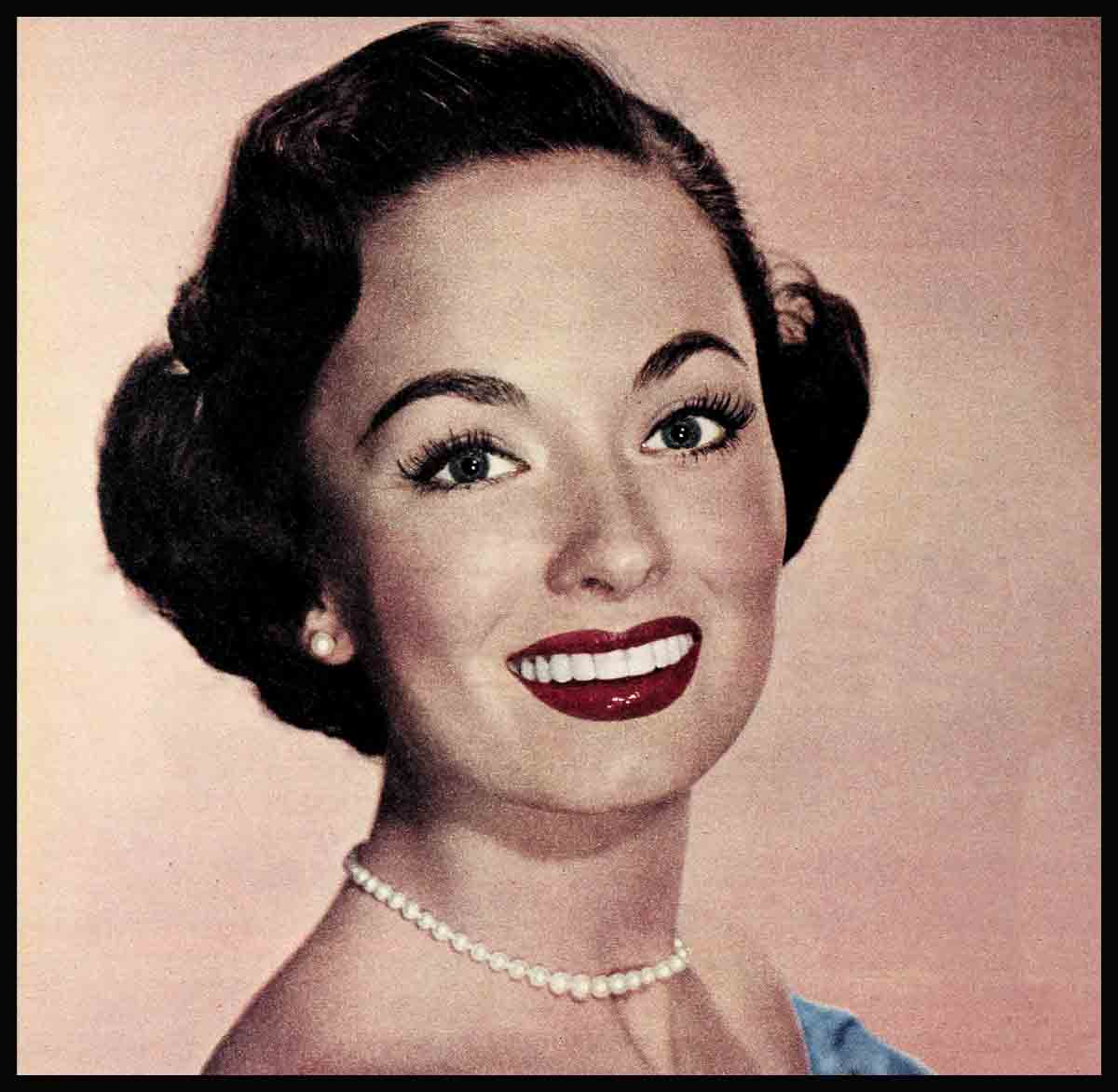
Ann Blyth’s Love Bank
Ann Blyth, being a very sensible and bright young girl, knew even before her wedding that marriage called for some adjusting, some give and take. She knew that just as most young couples make a down payment on a house, move in and must continue to make payments to a bank in order to make that house a long-lasting possession, so must regular payments be made to the invisible bank of love in order to maintain a solvent marriage. Ann knew an emotional shelter against the storms of daily living and marriage have to be planned for in advance. That they must be built day by day upon the cornerstone of devotion with a hundred and one little deeds of confidence, consideration, understanding and respect. Without these, a young couple cannot build a working partnership.
“I was prepared—or thought I was—” laughs Ann today, “to make some adjustments in my habits and schedule and to accept the little tensions and strains that might come from our separate careers or from minor domestic problems. But I didn’t realize the adjustments would start so soon.
“When we returned from our honeymoon, we unpacked, opened the additional wedding gifts that had come; checked in with the studio and the hospital and called our relatives and friends, then wrote a few urgent thank-you notes and answered some pressing invitations—finally, at midnight, we tumbled into bed, exhausted.”
Ann slept with the concentration of an honest rock when she was sent, suddenly, spinning into upright wakefulness by the explosion of the telephone. Dr. Jim, gifted with wonderful coordination and general familiarity with having his teeth rattled on a twenty-four-hour basis—answered at once. A patient announced that she was positive the stork was about to catch her.
Dr. Jim asked a series of questions, suggested that she return to bed. Everything was all right, he assured her; she was not to worry and if there were any further developments to call him back.
He hung up, burrowed into his pillow and ten seconds later was breathing regularly in the manner of a happily sleeping man with a healthy conscience.
Mrs. Jim lay quivering in her bed, worrying about the expectant mother, about the possibility of Dr. Jim’s having to get up and make a mad rush to her bedside, about whether he would make it in time.
To some people, awakening in the middle of the night is filled with a thousand nameless anxieties and horrors. Ann has always been one of those people. She has tried to conquer the trouble, blaming it on some forgotten childhood experience which a sensible adult should outgrow.
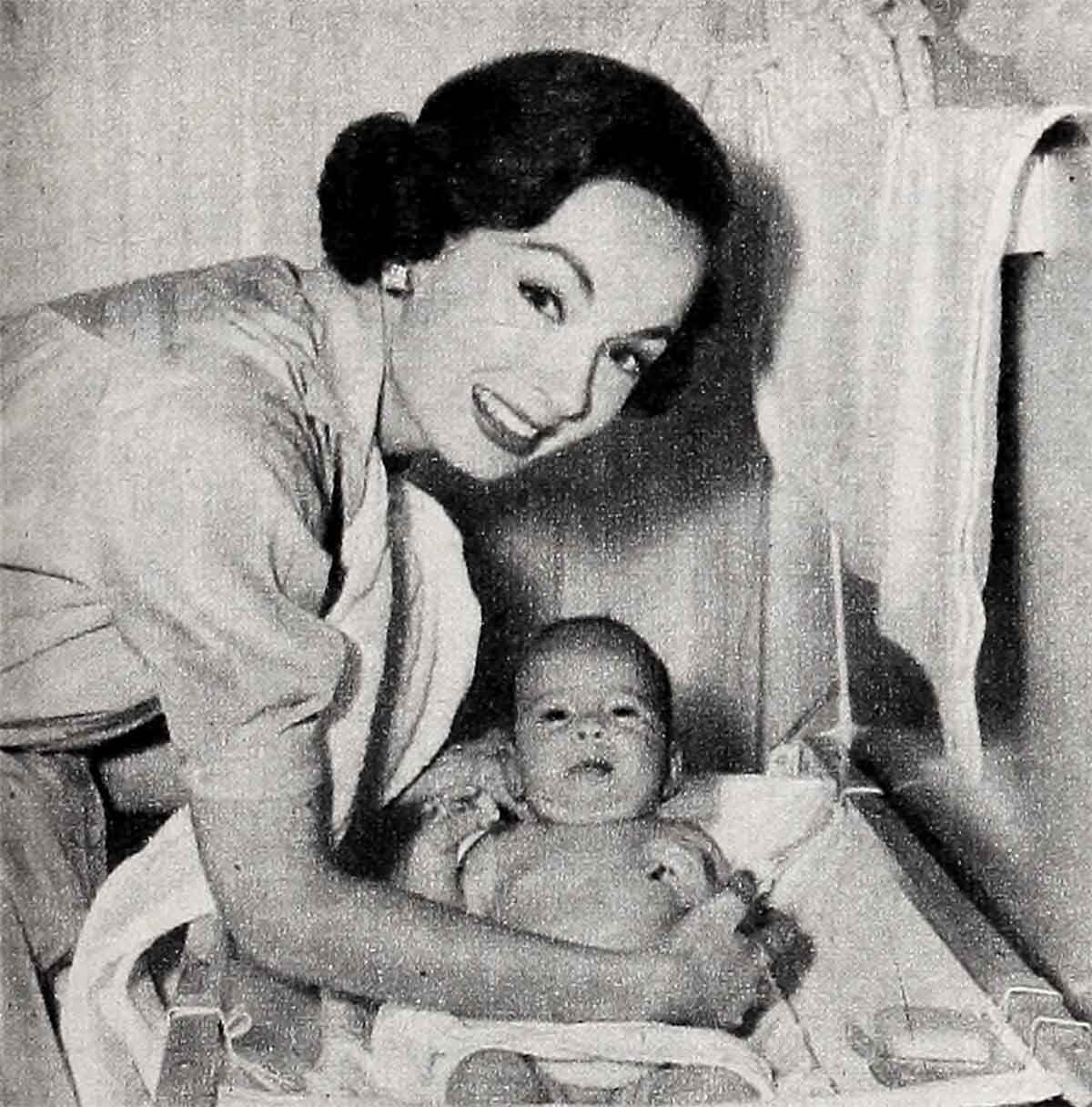
At last she talked herself into a state of calm and was floating through the first clouds of unconsciousness when—cllllang—there went the telephone again. A glance at her new luminous clock indicated that seventy minutes had elapsed since the previous call.
Dr. Jim answered again, again placated his patient, again asked a series of questions. “No,” he said in his reassuring voice. “You have plenty of time, yet. Relax, take a glass of warm milk and get some sleep.”
Well, this business went on hourly until Dr. Jim left for the hospital to meet his patient at 6 a.m. (Incidentally, at nine that evening, Dr. Jim telephoned Ann to announce the arrival of the patient’s first son, nine pounds, nine ounces.)
A single such isolated night would soon seem funny in retrospect, but the life of a doctor’s wife is made up of many such nights.
“During those first few months I was tired all the time,” remembers Ann. “I was sleepy during the day, but at night I couldn’t sleep.”
Late that summer Ann had to go on location for “Rose Marie.” While there, she discovered that, although the mountain nights at Mammoth Lakes were devoid of telephone jangles, she still awakened periodically. The difference was that she was able to convince herself that nothing catastrophic had happened and could return immediately to sleep. Apparently anticipation of the next ringing of the telephone was as much to blame for her restlessness at home as the actual disturbances. When she returned home she talked this problem over with Dr. Jim, who gave her some helpful hints.
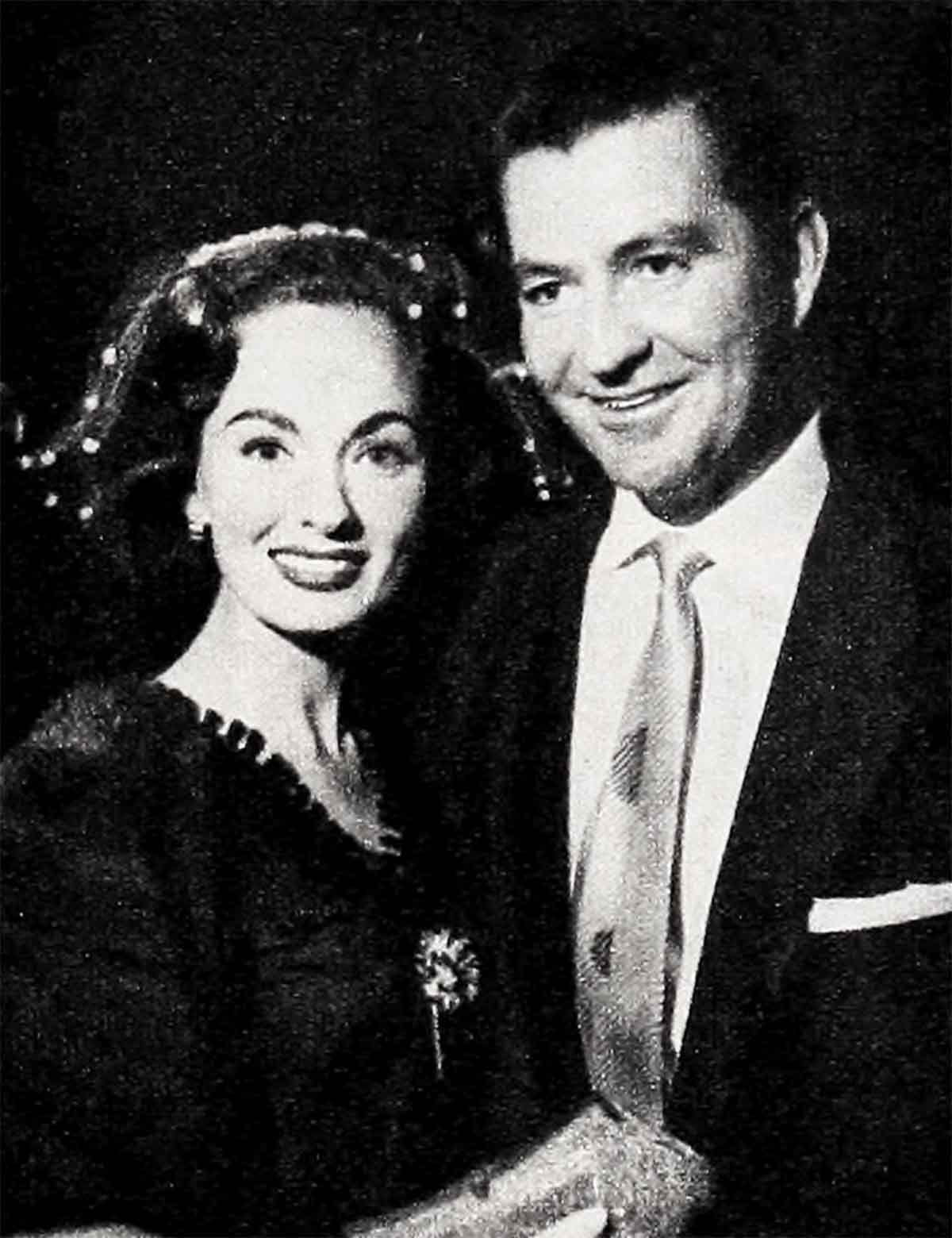
He explained that a doctor sleeps in gulps, deeply, and probably gets more rest in that way than a sleeper who tosses and turns for eight or nine hours. He added that each night call had to be regarded as unusual and not to be repeated within an hour or two. “Don’t let yourself think, ‘Now I’m going to have a terrible time getting back to sleep.’ Remember that sleep is deepest during the first hour or two after you’ve fallen off to sleep, so think, ‘Now I’m going to relax into another wonderful hour or two of rest.’ ”
Dr. Jim also had something to say about fretting in general. “If you really want to tie yourself in knots, start thinking about all the heartbreaking things in this world that you, personally, can’t change, that you can’t even improve. That will fix your sleep for years.” He added certain comforting comments on the snugness of their home and the devotion that lived within it.
All of this was Dr. Jim’s contribution to the seasoning of a doctor’s wife and the adjustment within a doctor’s home. It was made possible because she had the courage to discuss her problem.
Ann’s contribution to the partnership, in this particular instance, took two forms. First of all, she determinedly followed Dr. Jim’s suggestions and found that they worked. More important, she found a way in which she could become as much a part of his work as possible.
Ann established what she calls “Our Quiet Hour.” During each day, she and Dr. Jim take whatever moments are possible in the midst of their bustling life to shut out the rest of the world. Usually this pause in the day’s occupation comes comfortably around the dinner hour. Each discusses the happenings of the day so that the other knows what victories or vexations have occurred.
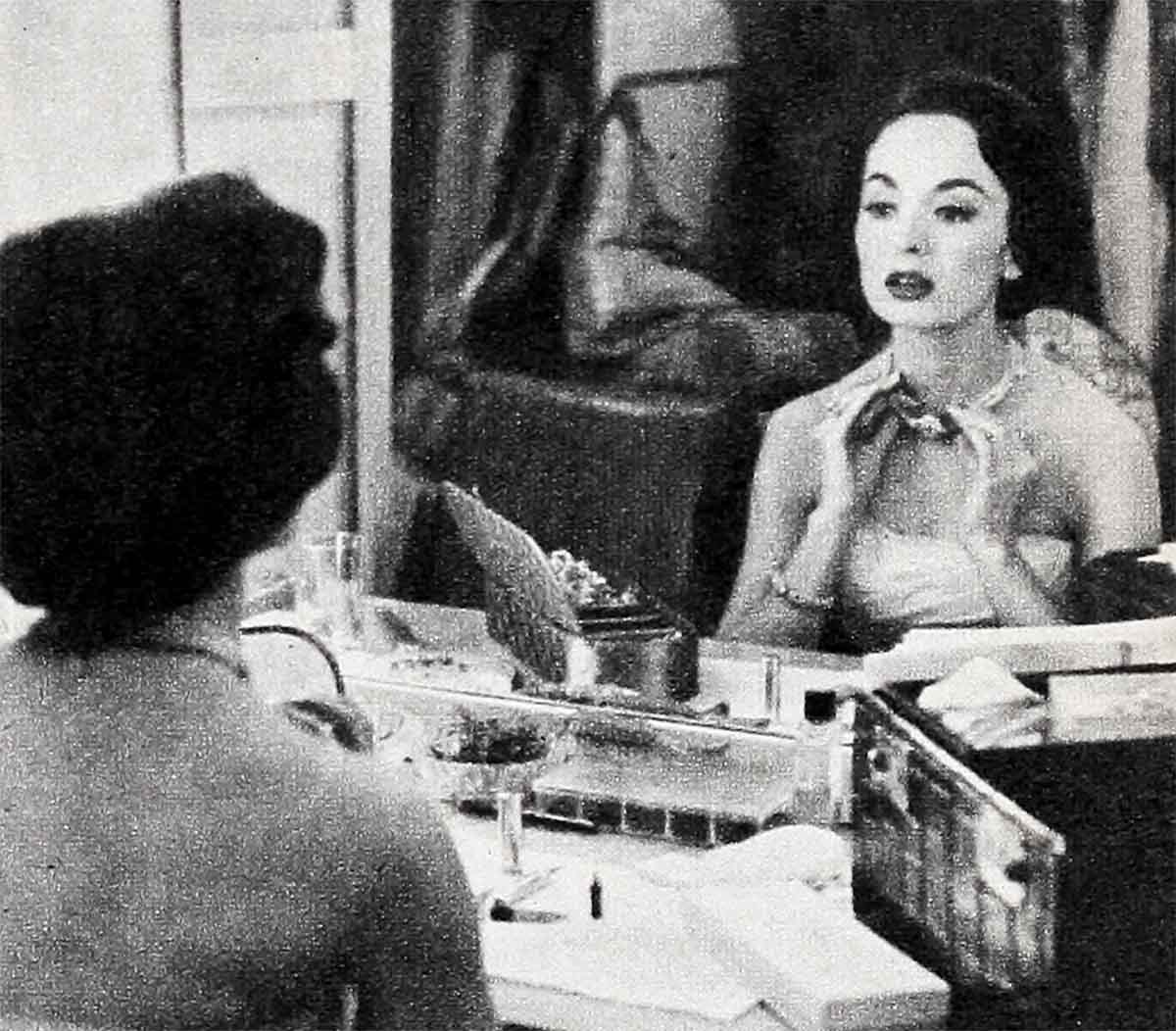
Ann says, “In that way I began to know something about Jim’s work and he began to know about mine. Nowadays, if something has gone wrong for either of us, the other knows exactly what. It seems to me that many family difficulties are caused by the silences into which certain people retreat when things get too hectic. Anyone living with such a person might think that he had made some big mistake, and having searched his conscience and found it clear, might become silent and accusatory, too.”
The in-law problem gets a mild-to-major airing almost every time a divorce case comes to trial. Ann believes that one of the best possible investments two people can make in their matrimonial future is to come to an understanding about in-law problems before they make appearance.
Luckily, Ann’s wonderful aunt and uncle made warm friends of the McNulty clan at once. However, feelings can always be hurt—usually over minor circumstances—so Ann felt that advance arrangements would spare everyone. One year, Thanksgiving dinner is enjoyed with Ann’s people; the next year it’s shared with the McNulty’s. Ann and Dr. Jim spent Christmas of 1953 with the McNultys, then dropped in to see her relatives in the evening. Christmas of 1954 was spent with Ann’s kinfolk and an evening call was paid on the McNulty clan.
Naturally, Ann is imbued with clan spirit, yet with a wisdom that penetrates more deeply than an emotional bias toward the Irish. She believes that every bride should get to know her husband’s people well. After all, the qualities she admires in her husband were inherited from or taught by his family. Ann refuses to find it remarkable that she has become a McNulty in spirit as well as in name “because they are such wonderful people,” but this has been part of her marriage investment.
Those who know both Ann and the McNultys say that it would have been easy for a bride to be jealous of the devotion of the McNultys and to seek to place an unspoken but determined barrier between her husband and his relatives.
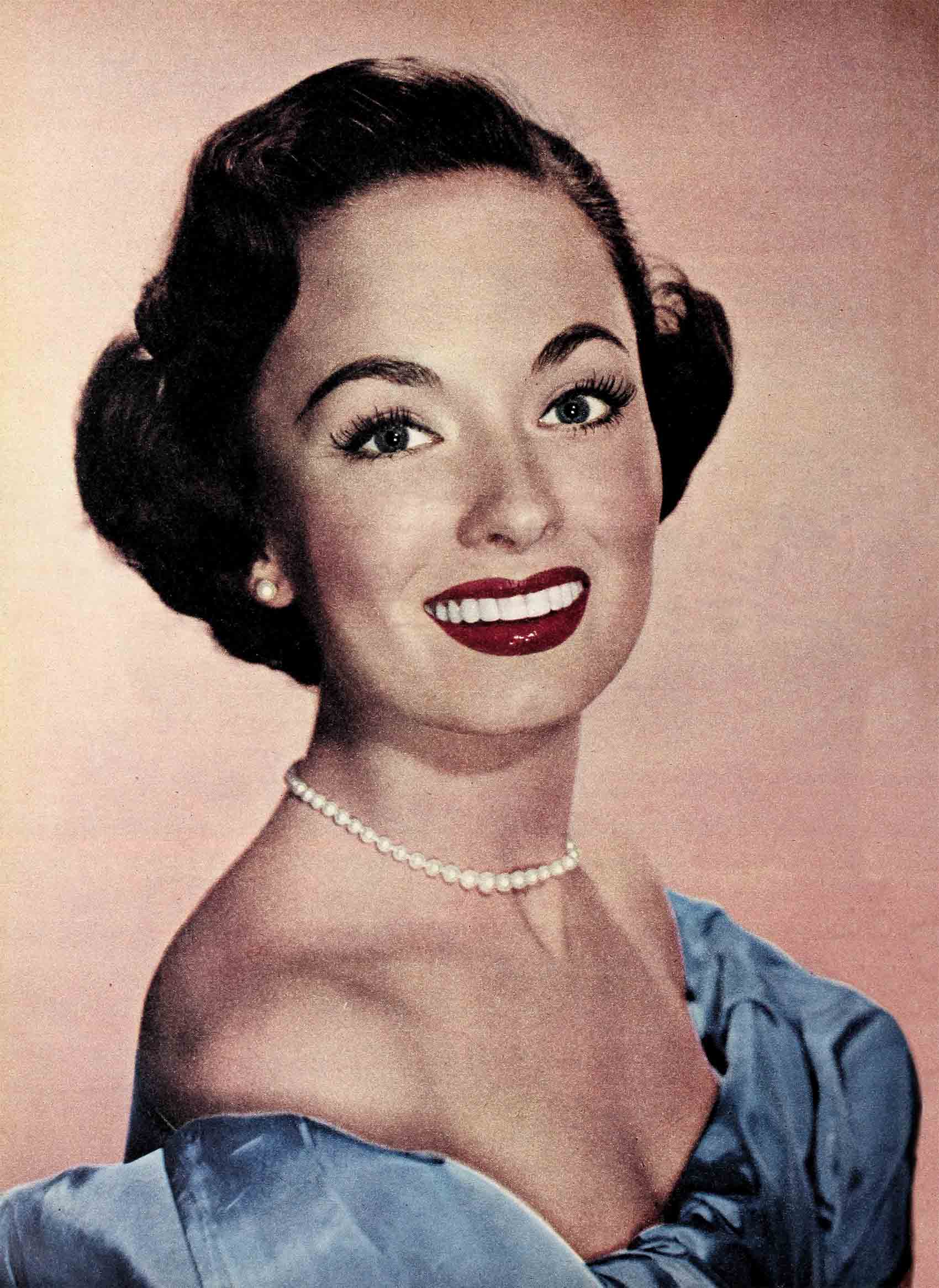
Another girl might not have become a sister in affection, as well as in law, with the other McNulty wives, and she might not have made it ms business to keep Dr. Jim’s parents informed of the small but preciously important daily happenings in their son’s life.
The chief reason given for the recent bust-up of a widely known Hollywood couple was social incompatibility. He was bored by her friends; she had nothing in common with his. He found her professional social life artificial; she found his so single-track that anyone outside his profession was made to feel as lost as an Eskimo on the Congo.
Early in her own marriage Ann became, when with her husband’s friends, the person she most loves to be: a doctor’s wife. Naturally she met the wives of medical men and those in allied callings and she found their conversation fresh and diverting after the theatrical talk with which she was familiar. She added a new dimension to her vocabulary and her viewpoint.
Ann found that, “I’m stimulated by talking to girls who don’t know much more about motion pictures than what is playing at Grauman’s Chinese. However they do know classical music, classical and modern literature and most of them are talented mothers and home managers.”
She has integrated herself so well with the medico-social group in Los Angeles that informal society columnists refer to the McNultys as “Ann and Dr. Jim” without adding, behind Ann’s name the fame-distinguishing Surname (Blyth) in the usual parentheses.
Inevitably there came a day when the McNultys were invited to two dinner parties scheduled for the same evening. One invitation came from a motion-picture couple whose bids represent a command performance to many a young actress. The second invitation came from one of Dr. Jim’s best friends. Ann weighed the situation. Normally she discusses all social activities with Dr. Jim in advance and, together, they decide upon the best course to follow. However, if she should discuss this particular instance with him, he would point out that one party was important, the other would be a fun fest with friends who could be seen at another time. Yet, Ann thought, Dr. Jim hadn’t been in touch with these friends for months because of pressures both upon him and upon the friends. A long time might pass before another opportunity would present itself.
Without making anything of it when she told her husband about the dual invitations, Ann wrote a sincere note of regret to the motion-picture hostess and accepted the invitation from Dr. Jim’s friends.
“It wasn’t anything, really,” Ann told a close friend. “Just a very small investment in our partnership. The time may come when I won’t be able to make a choice. I’ll simply have to do what my profession makes necessary but when that time comes, Jim will understand.”
On another occasion Ann had accepted an invitation to one of those cellophanetent and Hawaiian-torch parties and had invested in a new dress for the occasion. However, as the party night drew near, Dr. Jim was almost worked into an ulcer. One of the doctors in his group was ill, so Dr. Jim had to take over his duties. The second doctor had to make an out-of-town trip and an emergency arose in his practice which Dr. Jim had to meet. The stork, mischievous as usual, put on a population drive to take up any spare moment in which Dr. Jim might have tried to catch his breath.
On the morning of the gala, Ann waved her doctor off to the iodine wars. She noted the droop of his broad young shoulders, usually so square, and she heard the tired tempo of his stride, usually so brisk.
She went directly to the telephone and explained Dr. Jim’s heavy duties to the evening’s hostess and asked to be excused. “I know it’s going to be the party of the season, and I hate to miss it, but I’m convinced that Jim isn’t equal to it,” she said.
“And you’re right to consider him first,” agreed the hostess, who has been married over thirty years.
When Dr. Jim came home that night and asked if he would have time to grab a quick nap before showering and dressing for dinner, Ann told him what she had done. His grateful grin was more satisfying than a dozen dazzling dinner parties.
Such incidents represent large investments in married happiness, but Ann believes also in depositing pennies.
Shortly after she and Dr. Jim were married, Ann dressed for dinner and the theatre one evening, then sought Dr. Jim’s approval.
“You look beautiful—as always—but I was just wondering. Are you particularly fond of that shade of brown?” he wanted to know.
Ann said she had bought the dress for its lines and practicality, hadn’t thought much about the color. She had always worn a great deal of brown, she added.
“Well, maybe red—or a clear green, or . . .” suggested the typical man, trying to compress into words a nebulous feeling.
That ended the discussion, but Ann eliminated that shade of brown from her wardrobe.
Advertising has successfully planted the idea in the minds of men that women love gifts at any time, for any reason. Comes now Ann McNulty with the good word that men, too, appreciate tokens of affection. “I don’t agree with girls who moan that men are impossible to buy for.”
To prove her theory, Ann breezed through her Christmas shopping last winter with a minimum of effort and a maximum of appreciation, not only on Christmas morning, but during the months that have followed. On her list for Dr. Jim were such items as a cashmere sport coat, a plaid flannel bathrobe, a valet bag for automobile trips, a tinted portrait of herself and young Tim and various sets of cuff links.
As for Dr. Jim, he’s no cube in the gift department; he still marks every month an anniversary with a present. Sometimes it’s a flacon of perfume for Ann’s purse, sometimes a monogrammed handkerchief, a corsage, a scarf or nylons. Ann can always count on the remembrance being the right size, color or fragrance, evidencing that Dr. Jim has given it much thought which is the chief message of any gift.
Ann believes that another vital investment in married futures is the extra-large family-size dream. She and Dr. Jim have several. For one thing, both love New York but have never been there together. In off moments they discuss “riding a carriage through Central Park, taking the ferry to Staten Island, visiting the Statue of Liberty, window-shopping on Fifth Avenue—you know, all the touristy things that are wonderful when two people are in love.”
They plan, one day, to make trips to the Bahamas and to Rome, and—because Dr. Jim was in the Pacific during World War II—he wants to take Ann to see some of the fascinating lands of the Orient.
Of course, the greatest of all investments in marriage is represented by a chubby gentleman named Timothy Patrick McNulty who will be a year old on June 10, 1955. According to Ann he is merely the healthiest, cutest, smartest, brightest, happiest . . .
The meaning of these superlatives can be compressed into one brief statement of fact: Ann Blyth’s bank book may not show that she’s a millionaire, but her romantic resources are beyond count. She has been banking on love and her dividends in happiness are assured.
THE END
—BY ROBERT EMMETT
It is a quote. PHOTOPLAY MAGAZINE MAY 1955




